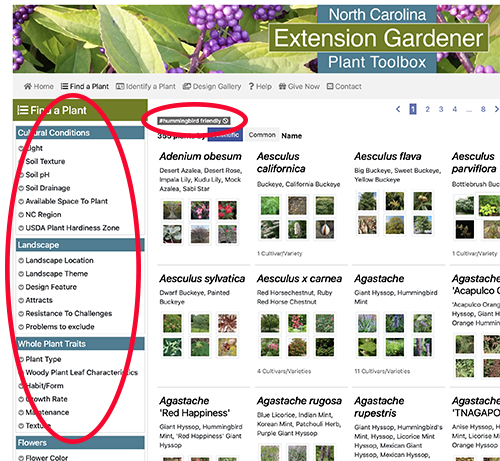Using the Plant Toolbox to Find Plants That Attract Pollinators
go.ncsu.edu/readext?948404
en Español / em Português
El inglés es el idioma de control de esta página. En la medida en que haya algún conflicto entre la traducción al inglés y la traducción, el inglés prevalece.
Al hacer clic en el enlace de traducción se activa un servicio de traducción gratuito para convertir la página al español. Al igual que con cualquier traducción por Internet, la conversión no es sensible al contexto y puede que no traduzca el texto en su significado original. NC State Extension no garantiza la exactitud del texto traducido. Por favor, tenga en cuenta que algunas aplicaciones y/o servicios pueden no funcionar como se espera cuando se traducen.
Português
Inglês é o idioma de controle desta página. Na medida que haja algum conflito entre o texto original em Inglês e a tradução, o Inglês prevalece.
Ao clicar no link de tradução, um serviço gratuito de tradução será ativado para converter a página para o Português. Como em qualquer tradução pela internet, a conversão não é sensivel ao contexto e pode não ocorrer a tradução para o significado orginal. O serviço de Extensão da Carolina do Norte (NC State Extension) não garante a exatidão do texto traduzido. Por favor, observe que algumas funções ou serviços podem não funcionar como esperado após a tradução.
English
English is the controlling language of this page. To the extent there is any conflict between the English text and the translation, English controls.
Clicking on the translation link activates a free translation service to convert the page to Spanish. As with any Internet translation, the conversion is not context-sensitive and may not translate the text to its original meaning. NC State Extension does not guarantee the accuracy of the translated text. Please note that some applications and/or services may not function as expected when translated.
Collapse ▲The Extension Gardener Plant Toolbox has improved its pollinator plant listings. You can now use the “Find a Plant” feature to zero in on plants that attract different kinds of pollinators, including moths, butterflies, hummingbirds, bees, and specialist bees.

Select Find a Plant, then use the Attracts menu.
In the left-hand Landscape menu, click on Attracts to reveal a list of wildlife that you may wish to attract to your garden. You can select specific kinds of pollinators, such as hummingbirds, or “pollinators” in general, to get a list of plants that are attractive to those critters.

Type the name of the pollinator into the Search box and see the tag listed in the drop-down menu.
Alternatively, you can use the Search box and type in the kind of pollinator you wish to attract. Searching by tags will generate a list of plants that have those tags.

Refine your search by selecting attributes from the left-hand menu.
In both cases, you can further refine your search by using the left-hand menus to narrow the list by growing region, light environment, plant life form, etc. Additional tips on how to get the most out of the Plant Toolbox can be found on the Plant Toolbox Help Page. You can also watch this 3-minute video tutorial on how to find pollinator-attracting plants using the Plant Toolbox.


